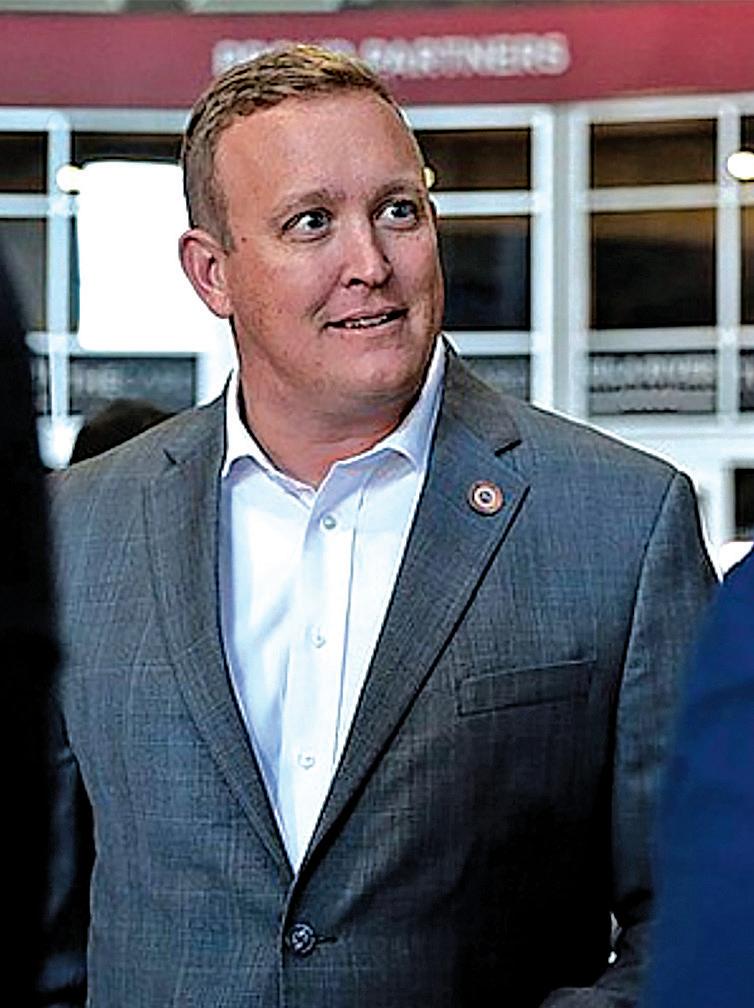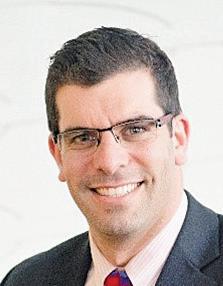










After months of study, speculation, and delay Korean energy giant
LG Energy Solution has announced it will break ground this year on a $5.5billion lithium battery manufacturing plant in Queen Creek with production to start in 2025.
The announcement quadruples LG’s initially announced investment of $1.4 billion
made early last year and the plant likely will create thousands of jobs.
LG’s North American subsidiary bought 650.5 acres at Ironwood and Germann roads in a state Land Department auction last April for $84.4 million and the town has been upgrading roads around the site in anticipation of the development.
The bid was the only one cast for the State Trust Land parcel is near Zimmerman Dairy Farm and CMC Steel Arizona, southeast of Phoenix-Mesa Gateway Airport.
“We are so excited that LGES is expanding this pivotal project that supports the demand for innovative clean energy solutions,” Queen Creek Mayor Julia Wheatley said. Stating “the substantial investment will create a positive ripple effect for the region and the state, bringing local jobs, infrastructure, and capital investment,” the mayor added, “LG Energy Solution will be the first company to break ground along the ad-
see BATTERY page 4
David Brewer was headed into high school back in Illinois when he realized he had an important life choice to make.
He loved basketball, which he still plays avidly as a Queen Creek resident now, but he was also really into music.
As is the case with many high school athletes with dreams of going pro, his trumpet took a back seat.
“I have no regrets about picking basketball once I went into high school,” Brewer said. “But right after high school you realize ‘Oh, I’m not going to the NBA. Music is going to
BAND page 6









































The Chandler Unified School District has settled its lawsuit against Juul Labs Inc. and other vaping companies but officials are not giving any details about it.
“Under advice of counsel, we cannot comment on the terms and conditions of the agreement between Chandler Unified School District and Juul Labs Inc. at this time,” said district spokeswoman Stephanie Ingersoll.
The district said in a follow-up statement that it could not disclose details because of a confidentiality clause in the agreement.
“While the District recognizes public policy favors disclosure of public records, the countervailing interests of confidentiality and the best interests of the state prevent disclosure of the settlement agreement,” the statement said.
“The terms of the settlement agreement are confidential; the confidentiality terms were carefully negotiat-
ed between the parties. Release of the settlement would entail a substantial disclosure of defendants’ confidential commercial information.’”
The CUSD Governing Board approved the settlement without comment March 8 in connection with a lawsuit the district filed on March 7, 2022.
It was one of hundreds filed by school districts across the country against the tobacco company, seeking compensation because they had to deal with the fallout of a teen vaping epidemic.
In the lawsuits, districts claim they had to devote resources to monitoring and policing vaping in school. Many started education campaigns to warn students and parents of the dangers of vaping. Both Kyrene and Tempe Union school districts have filed similar suits but have not settled yet.
The districts accused Juul and others of marketing directly to children.
The Wall Street Journal reported in December that Juul had agreed to settle more than 5,000 cases with 10,000 plaintiffs filed against them by school dis-
tricts, local governments and individuals for about $1.7 billion.
The company had agreed in September to settle a multi-state investigation for $438.5 million.
Juul offered fruit and candy flavors, which proved popular with many teens. It is illegal for anyone younger than 18 to purchase e-cigarettes.
CUSD says it will use whatever money they get from the settlement to address vaping.
“We anticipate the settlement being used as compensatory redistribution by means of prevention, intervention and postvention programming to address the problems of youth nicotine and vaping addiction,” Ingersoll wrote.
The Palm Beach Post reported Palm Beach County School Board settled for more than $10 million over five years. The Chicago Tribune reported District U-46 settled for $1.2 million.
There are about 192,000 students in the Palm Beach district and 35,000 in the U-46 district. CUSD has about 45,000 students.
In other news from the March 8 meeting, the district is placing orders to purchase more school buses. What’s different is they are 2025 buses.
Lana Berry, the district’s CFO, said they have to purchase them this early because of supply chain shortages that are slowing down delivery. She said the district is still waiting delivery of buses it bought 18 months ago.
The Governing Board approved spending more than $1.8 million to buy 10 2024 special education buses and $2.5 million to purchase 10 2025 general education buses.
“Our orders that we placed in May of 2021 are still not here,” Berry told the board. She said while they are waiting for delivery, the bus manufacturers could raise the price and give the district a take it or leave it demand, knowing there are other districts in need of buses.
“We’re really at … their mercy,” Berry said. “We really need the buses.”
In addition to the buses the Gov-

An edition of the East Valley Tribune
Queen Creek Tribune is published every Sunday and distributed free of charge to homes and in single-copy locations throughout Queen Creek
CONTACT INFORMATION
Main number: 480-898-6500
Advertising: 480-898-6559 Circulation: 480-898-5641
Publisher: Steve T. Strickbine
Vice President: Michael Hiatt
ADVERTISING DEPARTMENT Display Advertising: 480-898-6309
Classifieds/Inside Sales: TJ Higgins | 480-898-5902 tjhiggins@TimesLocalMedia.com Steve Insalaco | 480-898-5635 sinsalaco@TimesLocalMedia.com
Advertising Sales Executive: Jane Meyer | 480-898-5633 jane@TimesLocalMedia.com
NEWS DEPARTMENT
Executive Editor: Paul Maryniak | 480-898-5647 pmaryniak@TimesLocalMedia.com
Managing Editor: Cecilia Chan | 480-898-5613 cchan@TimesLocalMedia.com
Reporters: Mark Moran | 480-898-5601 | mmoran@TimesLocalMedia.com Ken Sain | 928-420-5341 ksain@TimesLocalMedia.com
Sports Editor: Zach Alvira | 480-898-5630 | zalvira@TimesLocalMedia.com
Photographer: Dave Minton | dminton@TimesLocalMedia.com
Production Coordinator: Courtney Oldham | 480-898-5617 production@TimesLocalMedia.com
Design: Ruth Carlton | rcarlton@TimesLocalMedia.com
Circulation: 623-535-8439
Circulation Director: Aaron Kolodny | aaron@TimesLocalMedia.com

from page 1
vanced manufacturing corridor.”
This is the single largest investment ever for a stand-alone battery manufacturing complex in North America, according to LGES.
It will consist of two facilities, one for 2,170 electric vehicle batteries and the other for “pouch type” lithium-ion phosphate batteries, which are used in rechargeable devices like power tools, electric bikes solar panels and laptops.
“Our decision to invest in Arizona demonstrates our strategic initiative to continue expanding our global production network, which is already the largest in the world, to further advance our innovative and top-quality products in scale and with speed,” said Youngsoo Kwon, CEO of LG Energy Solution in a press release.
“We believe it’s the right move at the right time in order to empower clean energy transition in the U.S.”

As the demand for rechargeable batteries grows in North America, the battery plant will bring the company closer to its customer base and save money on logistics and manufacturing, LGES said. In addition to being a huge investment, LGES also plans to launch new technology in the facilities, making its production decisions based solely on data. The company said those cost reductions would eventually bring down the cost of electric vehicles.
“By implementing this key measure to enhance product quality, the Arizona facilities will aim to increase yield,
improve manufacturing processes, and boost productivity to better respond to the ever-rising battery demands in the region,” the company said.
LGEG initially announced its intention to build the facility in Queen Creek almost a year ago. But months of speculation and study followed as the company said it was reevaluating.
Progress came to a standstill and raised speculation that the facility might not be built. That ended with Friday’s announcement.
“With this historic investment from LGES, Arizona has become the battery manufacturing capital of the country,” said Gov. Katie Hobbs in statement.
“These Arizona-made batteries will power green, sustainable technologies
around the world, cementing Arizona’s reputation as an innovation hub for renewable energy. We’re grateful to LGES for their legacy investment and for committing to making thousands of good-paying jobs for Arizonans,” she added.
The company’s decision to increase investment in electric vehicle battery production in North America comes from rising demand from electric car makers like Tesla for locally manufactured high-quality, high-performance batteries to satisfy the Inflation Reduction Act’s tax credits for electric vehicles, according to LGES.
“Situating the new ESS battery facility

BATTERY from page 4
in North America, the biggest ESS market globally, LGES aims to respond to the fast-growing needs for locally manufactured batteries on the back of the IRA, and further expedite clean energy transition in North America upon the strong government policies supporting the adoption of ESS,” the company said. LGES’s announcement is the latest in a series of battery-related announcements in Arizona and nationwide. Ford said last month it would build a $3.5 billion battery factory in Michigan and has plans to for battery plants in Kentucky and Tennessee, partnering with another Korean company, SK On, according to the New York Times.
A wave of new factories is expected to
increase battery manufacturing capacity in North America tenfold from 2021 to 2030.
LG did not start out as the huge electronics and battery manufacturing conglomerate it has become.
Lucky Chemical Co. was established in 1947 as a cosmetics company whose first star product was called Lucky Cream when it opened a lab in the 1950’s in Korea, where it used plastic injection technology to make plastic combs, and soap dishes, according to an article last year in Newsweek about the history of LG.
While town officials say it will be good for the local economy, the facility last year raised concerns among some neighboring residents, who worry it could pose environmental damage and threats to people, pets and livestock.

Mesa AZ – When it comes to chronic pain and/ or neuropathy, the most common doctor-prescribed treatment is drugs like Gabapentin, Lyrica, Cymbalta, and Neurontin.
The problem with antidepressants or anti-seizure medications like these is that they offer purely symptomatic relief, as opposed to targeting and treating the root of the problem. Worse, these drugs often trigger an onset of uncomfortable, painful, and sometimes harmful side effects.
The only way to effectively treat chronic pain and/or peripheral neuropathy is by targeting the source, which is the result of nerve damage owing to inadequate blood flow to the nerves in the hands and feet. This often causes weakness, numbness, balance problems. A lack of nutrients causes the nerves degenerate – an insidious



As displayed in figure 1 above, the nerves are surrounded by diseased, withered blood vessels. A lack of sufficient nutrients means the nerves
cannot survive, and thus, slowly die. This leads to those painful and frustrating consequences we were talking about earlier, like weakness, numbness, tingling, balance issues, and perhaps even a burning sensation.
The drugs your doctor might prescribe will temporarily conceal the problems, putting a “Band-Aid” over a situation that will only continue to deteriorate without further action.
Thankfully, Mesa is the birthplace of a brandnew facility that sheds new light on this pressing problem of peripheral neuropathy and chronic pain. The company is trailblazing the medical industry by replacing outdated drugs and symptomatic reprieves with an advanced machine that targets the root of the problem at hand.

Effective neuropathy treatment relies on the following three factors:
1. Finding the underlying cause
2. Determining the extent of the nerve damage (above 95% nerve loss is rarely treatable)
3. The amount of treatment required for the patient’s unique condition
Aspen Medical in Mesa
AZ uses a state-of-the-art electric cell signaling systems worth $100,000.00.
Th is ground-breaking treatment is engineered to achieve the following, accompanied by advanced diagnostics and a basic skin biopsy to accurately analyze results:
1. Increases blood flow
2. Stimulates and strengthens small fiber nerves
3. Improves brain-based pain
The treatment works by delivering energy to the affected area(s) at varying wavelengths, from low- to middle-frequency signals, while also using Amplitude Modulated (AM) and Frequency Modulated (FM) signaling
It’s completely painless!
THE GREAT NEWS IS THAT THIS TREATMENT IS COVERED BY MEDICARE, MEDICAID, AND MOST INSURANCES!!
Depending on your coverage, your peripheral neuropathy treatment could cost almost nothing – or be absolutely free.
The number of treatments required varies from patient to patient, and can only be determined following an in-depth neurological and vascular examination. As long as you have less than 95% nerve damage, there is hope!
Aspen Medical begins by analyzing the extent of the nerve damage –a complimentary service for your friends and family. Each exam comprises a detailed sensory evaluation, extensive peripheral vascular testing, and comprehensive analysis of neuropathy findings.
Aspen Medical will be offering this free chronic pain and neuropathy severity evaluation will be available until March 31st, 2023 Call (480) 274-3157 to make an appointment
Due to our very busy office schedule, we are limiting this offer to the first 10 c allers Y OU DO NOT HAVE TO SUFFER ANOTHER MINUTE, CALL (480) 274-3157 NOW!!
We are extremely busy, so we are unavailable, please leave a voice message and we will get back to you as soon as possible.
BAND from page 1
be with me for the rest of my life.’”
Now, Brewer, who still plays music as a hobby, is trying to help make it available for other people, too.
He is providing what he sees missing for aspiring musicians young and old: a place to jam.
That has been inspired by his other passion.
“We always played pickup basketball,” he said. “I was getting done one night sitting there thinking ‘why doesn’t something like this exist for music?”
Brewer is founder/CEO of Band Toogether, a collaborative music space wedged into a few hundred square feet of Queen Creek Realtor April Anderson’s Ellsworth Road office, where people can rent space for $25 for two hours and play music every Tuesday and Thursday evening from 6 to 8.
“The problem we are trying to solve is that if you’re not in school and you’re not a professional, there really is no infrastructure to allow that middle group of people to conveniently play music,” he said.
Brewer said schools provide practice and performance spaces for students and professionals have what they need. But people in the middle who love to play music do not have a place to do it.
“If you play at home, either your family or your neighbors get annoyed with you; if you try to go to a studio, it’s very expensive to do that and you must be taking it pretty seriously if you’re doing that,” he said.
Brewer’s solution was to work with his friend and business partner Shom Ban-
dopadhaya to put in lots of hours and a few thousand dollars of their own money to realize their vision.
Brewer also donated his own guitar equipment, drum set, piano, and various other large, big-ticket items he says people told him were hard to lug around just to jam for a few hours.
“So being able to have those bigger pieces of the puzzle there at Band Toogether, we are hoping people are really able to just come and enjoy rather than having to worry about getting their equipment to and from places,” he said.
If Band Toogether’s March 16 grand opening was any indication, Brewer has a hit on his hands.
He showed up to the space not really knowing what to expect – and found enthusiastic musicians there to meet him at the door.
“It was amazing. At 6 o’clock on the button, a gentleman walks in and started playing,” Brewer said. “And then another guy showed up and they started jamming together. They started playing an Eric Clapton song. It was awesome.”
Nick Dembicky and his 12-year-old son Alex walked in to see what Band Toogether was all about, and the vibe instantly struck a chord with the boy.
His dad said Alex, who has been trying to teach himself how to play drums on a used $100 set, walked up, sat down at the Band Toogether drum kit and started keeping rhythm.
“It was a magical moment for sure,” Nick said. “To see him go in there and start playing with guys three times his age... He kind of held a beat for a while.
It was really cool. If I was a little kid like that, I would have been nervous and I don’t know if I could have held a beat.”
Alex had a touch of guidance, Brewer said. One of the older musicians walked over to the drum set and tapped out the beat for Alex, who took it from there.
“It was really neat,” Dembicky said. “It was the first time he’s ever really played with anybody like that.”
Brewer said one of his goals for the space is to have generations of musicians coming together, with the older ones mentoring the younger ones, which was on display on opening night.
“That little guy had the confidence to go up there and everybody was really encouraging, welcoming, and he started playing,” Brewer said.
“The guitar player, the piano player, the 12-year-old drummer up there playing together blew my mind to see exactly what we had envisioned and what they were already making of it and what it could be. It gave me goosebumps.”
Dembicky said the concept of having a community space for music is a good one, especially for young people. He added he and his son will be back to Band Toogether, most likely regulars.
“Bringing people together for art and music is a really cool thing and it’s good for kids. It’s kind of a healthy outlet,” he said.
“Kids get in trouble when they don’t have things to do and I think it’s good for Queen Creek to have something like this for people coming together and is good in the town. For kids and parents alike to have an outlet to do something like that, I
think it would be really cool, you know?”
Brewer hopes Band Toogether will expand beyond Queen Creek, catching on the way short-term rental properties have.
Someone rents out a space to musicians like him, the way April Anderson has with part of her office, and creates a common space for them to jam while making additional money from their empty after-hours office space.
“But it’s more than the money,” Brewer said. “They believe in music. They believe in the Arts. They want to be able to help bring that part of the community to life.
“The human element is special. When you get locked in and start playing with a group of people, it just means so much more,” he continued.
To Brewer, music and basketball still have a lot in common, and now he does not have to choose one over the other. He still plays both and sees similarities between them almost every day, especially with it comes to teamwork and even the unpredictability.
“This is exactly like basketball,” Brewer said. “No one knows who is going to show up again.”
Who: Band Toogether
Where: April Anderson Realty, 21408 S. Ellsworth Road, Queen Creek.
When: 6-8 p.m. Tuesday’s and Thursday’s. Info: band-toogether.com

If some state lawmakers get their way, those AA-labeled eggs you find at the store later this year -- and pay a premium for -- may not be as fresh and tasty as they are now.
On a 4-3 vote, the Senate Commerce Committee last week agreed to allow eggs with an AA rating to remain on store shelves for 30 days – six days longer than now permitted.
Rep. Michele Pena, R-Yuma, said Arizona is only one of two states with such a short limit. She told lawmakers that other states allow AA eggs on shelves for 30 days and some have no statutory pull-by date.
There’s no evidence eggs older than 24 days are unsafe. Arizona allows A-graded eggs to be sold for up to 45 days after being candled, which occurs shortly after they are laid and collected.
But Roland Mader of the Arizona Department of Agriculture said egg quality starts to deteriorate after 24 days, explaining, “The egg white gets more liquid, more watery.
“The cell membrane of the yolk, they lose the integrity,’’ Mader continued. And that, he said becomes most visible, when you break the egg into a pan and the yolk, rather than standing up, “is very flat.’’
What HB 2750 would mean, Mader said, is that someone buying a carton of AA eggs after 24 days would be getting what the state now considers a grade-A egg –something less than he or she paid for.
He said it’s no different than, say, the grades of beef that are available.
“If a customer purchases prime rib-eye steak, the customer expects and should be getting prime rib-eye steaks, not a lower grade,’’ Mader said.
Pena, however, argued there are good reasons to extend the sell-by dates of Grade AA eggs.
She reminded lawmakers of the recent shortage of eggs. But because that has been a national issue even in states with more liberal rules about how long eggs can be sold, Pena conceded she cannot link a shortage to Arizona’s 24-day rule.
“It was more of a capitalist mind-set that instigated all of that,’’ Sen. Theresa Hatathlie, D-Tuba City, said of the egg shortage.
What actually appears to be behind the measure are the desires of the Arizona Retailers Association, representing the stores that sell the eggs.
But in a prepared statement for the committee, Michelle Ahlmer, the group’s executive director, said the change is designed to help shoppers by keeping eggs available for sale for an extra six days.
“Consumers need all the help that can be provided,’’ she said.
There also is the claim that the 24-day limit results in $3 million worth of expired eggs being thrown out every year because it can be difficult to repackage AA eggs for sale at a lower grade.
“That simply doesn’t happen,’’ countered Glenn Hickman, president of the family-owned egg ranch that bears his name.
As the state’s largest egg producer, he testified he would know if retailers were dumping $60,000 worth of eggs a week.
Hickman does not dispute that some stores may find themselves with AA eggs past 24 days they cannot sell.
But he said the blame likely lies with poor management, saying his trucks deliver eggs to the average store three times a week and it is up to store staff to ensure that the stock is rotated.
Patrick Bray, lobbyist for the Arizona Farm and Ranch Group, questioned the accuracy of that $3 million claim.
He noted Ahlmer has been quoting that same figure since 2018.
That’s when she used it to convince lawmakers to allow those eggs initially graded A – usually because they have a larger air pocket which shows lower quality – to be sold up to 45 days after being laid, nearly twice as long as previously permitted.
Hatathlie supported the change, saying she doesn’t understand why there even are mandatory sell-by dates on eggs.
“I know that organic eggs, when harvested and cared for, will last even up to a




Saying he was doing what the Rev. Martin Luther King Jr. would have wanted, a Queen Creek senator got Republican colleagues to vote to outlaw diversity, equity and inclusion programs in state and local governments and the university system.
SB 1694, crafted by Jake Hoffman, bans the use of government money for any such program. It also forbids a public agency from requiring workers to engage in those programs, allowing those employees to sue.
But Hoffman told colleagues that he’s not against the ideas. What he opposes, he said, is what these programs include, ideas Hoffman argued actually work against the concepts of inclusion and equality.
“That’s a problem,’’ he said.
“The bill says we don’t want public entities influencing the composition of their workforce based on race,’’ Hoff-
man said.
He then quoted a line from King about children living “in a nation where they will not be judged by the color of their skin but by the content of their character.’’
“This bill seeks to do what MLK Jr. advocated for,’’ he said.
But Sen. Juan Mendez, D-Tempe, said proponents fail to understand that not everyone is coming from the same starting point and born with the same advantages.
“For those of us who did not win the cultural lottery, much of one’s life outcome can still be predicted by the biases towards race, class, ability and identity,’’ he said.
“Diversity, equity and inclusion programs are only set out to help us understand and prepare our citizens for what it means to live in a diverse and inclusive society,’’ he said. “It’s through these diversity, equity and inclusion programs that institutions are beginning to investigate and correct structural roadblocks that limit the access
to the resources and opportunities that improve lives and communities for everyone.’’
As approved, SB 1694 has a laundry list of what would be off limits.
For example, programs could not describe or expose systems, relations of power, privilege or subordination on the basis of race, sex, color, gender, ethnicity, gender identity or sexual orientation. Nor could they describe methods to dismantle or oppose those systems.
Also off limits would be advancing any theories of a host of theories ranging from unconscious or implicit bias and systemic oppression to inclusive language and neopronouns.
That last category includes words that go beyond the traditional “he’’ and “she’’ which, by their nature, identify the gender of the person to whom it refers. Instead it includes pronouns that do not express gender like “ze’’ and “zir.’’
Also outlawed would be concepts of “anti-racism.’’ Hoffman describes that
as the idea that “the only answer to past racial discrimination is present discrimination.’’
All of that, he said, goes to what he said is the goal of SB 1694 to treat people as equals.
Mendez, however, said all that ignores what he believes are the real intent of these programs. That, he said, seeks to educate that there are people in society who have not necessarily been treated equitably -- and that something should be done about that.
“But this proposal attempts to broaden the cultural wars, claiming that equity and inclusion and diversity is racist because it doesn’t put white, male, heterosexual, conservative views on a pedestal to remain unquestioned,’’ he said. “It should not be our job taking apart programs that are helping our citizens work together and work toward progress.’’
The party-line vote late Monday now sends the measure to the Republican-controlled House.
APhoenix lawmaker is attempting to salvage at least part of his controversial plan to override local zoning rules in the name of affordable housing after it was overwhelmingly rejected because of opposition from cities and towns.
The move comes after a bipartisan vote in the Senate two weeks ago quashed the plan by Republican Sen. Steve Kaiser to require cities to allow everything from higher density housing and taller multi-family complexes to eliminating requirements for off-street parking. City lobbyists said these were decisions best left to locally elected city councils.
Also helping to doom the measure was the lack of any guarantee that the radical revamp of state laws giving municipalities the right to control zoning would actually lead to more affordable homes or apartments.
Kaiser said in an interview that some of the wide-ranging measure’s provisions

multi-family property to much-taller and larger apartment units, and another that would allow developers to cram as many as six homes onto one lot.
“Obviously by-right was not helpful, so that’s that won’t be coming back,’’ Kaiser told Capitol Media Services. “And the small lots, people don’t like that.’’
The small lots were the part of the plan designed to kick-start the building of “starter homes,’’ entry-level homes affordable enough for first-time homebuyers.
Other parts of the measure, he said, will be revived.
That includes requiring municipalities to allow backyard casitas as long as they are not used as short-term rentals, allowing construction of duplexes and tri-plexes, and allowing manufactured housing to be used. Kaiser said they probably have enough support to make it through the Legislature.
backing of some Democrats in the Senate.
“I think there are necessary tools in this bill that need to be implemented in order to really address the housing crisis that we are facing,’’ said Sen. Anna Hernandez, D-Phoenix.
“And I think it will give us opportunities to build more diverse housing, more innovative and tailored to what some of our working families need or what some of our youth needs or some of our seniors.’’
Other Democrats opposed the plan, including Sen. Priya Sundareshan, who said her city, Tucson, already has made a lot of progress on issues addressed in the measure, including allowing backyard housing units.
are clearly dead, including one that said builders had the absolute right to convert existing commercial, mixed-use or
And limiting design reviews and allowing boarding houses also will likely be revived, he said.
The plan was supported by developers and some housing advocates, and won the
“And the problem that we see is that this pre-emptive approach might actually undo some of the efforts made there by overriding the regulations made to date and override potentially other initiatives that they have been taking in order to address the housing crisis,’’ Sundareshan said.
Sen. John Kavanagh called Kaiser’s plan





Sam Heivilin took aim and concentrated on pulling the trigger at the blue targets flying toward her while a train roared by noisily, blaring its horn.
The 16-year-old was participating in a simulated law-enforcement shooting exercise at the Gilbert Public Safety Training Facility. Sam and 30 other girls in grades 9-12 got a glimpse into firefighting and police operations as part of the Aspire Academy.
“I was not disappointed,” said Sam, a student at Gilbert Christian Schools’ high school and whose dad is a retired Mesa cop. “I dreamed of being a firefighter so I wanted to get some hands-on experience and get to put on some bunker gear, maybe take a ride in the truck and climb a bunch of ladders. Just hands-on experience to get to see if that is really what I wanted to do with my life.”

During the four-day overnight camp March 16-19, the girls took part in handson activities such as conducting a traffic stop, investigating a crime scene, rap-






pelling down buildings and climbing a 100-foot-tall fire truck ladder, doing

them side-by-side with women firefighters and cops from 19 law enforcement and fire agencies across the Valley, including from Mesa, Chandler, Scottsdale, Glendale, Avondale, FBI, Border Patrol and Bureau of Alcohol, Tobacco, and Firearms.
“It’s nice to see women in those roles and that they are excelling,” Sam said. This was the first time Gilbert’s 50-acre state-of-the-art joint training facility hosted the Aspire Academy. The academy is offered in the spring and fall and the next session takes place in Chandler. The program launched eight years ago, spearheaded by women in Mesa Police and fire departments.
“It’s a program we have to influence young girls who want to come out and potentially be law enforcement or firefighters,” Gilbert Officer Dani Covey said. “We have a chance first-hand to get to show them what the careers are like.” Covey said she wanted to be a police
ASPIRE page 12







officer since she was a kid.
“My dad was a police officer,” Covey said. “I actually drew a picture when I was in kindergarten that said, ‘when I grow up, I want to be a blue star just like my dad.’ He had blue stars on the side of his patrol car.”
Covey said many young girls don’t have that influence.
“They might think the career is completely different from what it is so we get to have them come out here and we give them first-hand experience of what it’s really like – a day in the shoes of a police office, a day in the shoes of firefighters.”
The program also is a good recruiting tool, especially for Gilbert Police, which has joined the national 30X30 Initiative, a pledge to increase the number of female police officers to 30% by the year 2030.
Research suggests that women officers use less force, are named in fewer complaints and lawsuits, see better outcomes for crime victims and are perceived by communities to being more honest and compassionate, according to the coalition of police leaders, researchers and professional organizations pushing to advance
women representation in policing.
Currently, women make up 12% of sworn officers and 3% of police leadership in the country, according to the Initiative. Women comprise 11.7% of the 373 full-time sworn officers on the Gilbert Police force, according to the department.
Police Chief Michael Soelberg at the council retreat in December talked about the initiative.
“By the year 2030, we need to show that women are as capable as being police officers as men,” Soelberg said. “And in some instances they may be even better. And I think it’s important that we let our communities know that we always hire the most qualified people not just based on gender. But we definitely need more women.”
According to Covey, the seven different agencies participating in the upcoming police academy at the training facility comprises 25% women, she said.
“When I got hired on I was the first female to have been hired for a little while,” said Covey, who’s been a police officer for almost a decade. “And now we are in every academy class.”
Covey said an open forum was held for

the girls to ask questions and it ran the gamut.
“They wanted to know about the hiring process, they wanted to know what the academy is like, they wanted to know what were some of the scariest things we’ve seen, they wanted to know if there is sexism on the job,” she said. “They are asking some of the hard questions and we are able to have those really good conversations with them.”
Covey said choosing a career in law enforcement is empowering.
“It’s a great opportunity for me,” she said. “Every day is something different. It’s a job where you don’t know what you’re going to get one day after the other. It’s exciting, it’s a very physically demanding job. So, I think for somebody who wants to better themselves and push themselves it’s a really unique opportunity and for me I know I love helping people in crisis.
“I’m part of the Crisis Intervention Team. For me what better opportunity when somebody is having their worst day, they call us and what a privilege it is for me to get to respond and help them and you really don’t get to do that in any other profession.”
HOMES from page 8
all-around bad.
The Scottsdale Republican called local zoning “a sacred thing,’’ and noted that people made decisions on where to make the biggest investment of their lives based on things like big lots – and the assurance that a developer can’t buy a vacant nearby property and cram it with six tiny homes.
“Trust me friends, I am no stranger to pre-empting cities and towns,’’ said Kavanagh.
Sarah Dutton, who’s been a Gilbert firefighter for 1-1/2 years, said the purpose of the academy is to show the girls they can do the jobs traditionally dominated by men.
“For me growing up, I didn’t know anyone in the fire service but especially I didn’t know any women,” she said.
“But being able to band together, we have so many different departments out here, coming together to collaborate on this and we are able to show these girls that if we can do it so can they. The biggest takeaway we are trying to teach them is they can do hard things they might not think they can but we show them that they can do it.”
She added that the girls gain confidence from completing their tasks and they also learn problem-solving and other life skills at the academy.
Maclayne Justus, a 17-year-old student at Perry High School, said she took the academy because of her dad Mark Justus, a deputy chief with Gilbert Fire and Rescue. And, the Queen Creek resident said she recently earned her pilot’s license and was eyeing a career as a fire pilot.
see ASPIRE page 13
build on their properties. And he noted that there is a backlog of about 23,000 apartments waiting to be built in Maricopa County, some with permits and approvals dating back to 2018.
“There’s parts of the process we control, there’s others that we don’t, but what we can control we want to improve upon,’’ Ponder said. “But the way that SB 1117 does it just is a no-go for our municipal residents.’’


“But I do draw a line at kneecapping,’’ he said during the vote on SB1117, which failed 20-9. “And this bill kneecaps local control. And local control is basically what our constituents want.’’
Kaiser’s plan is premised on the contention that local zoning rules and “NIMBY-ism,” the not-in-my-backyard opposition from existing residents to new development, is a key reason Arizona has a major housing shortage.
But Nick Ponder, a lobbyist working with the League of Arizona Cities and Towns, called that a flawed argument at best.
He said cities do not control who buys and holds land, or when they decide to
And he said local opposition is not the only reason some developments are denied.
Ponder also noted that cities have been hamstrung in addressing the housing shortage by laws backed by the state apartment association, builders and conservative groups like the Goldwater Institute, groups now pushing for the changes in Kaiser’s bill.
He said builders pushed legislation barring cities from collecting impact fees for things like the costs of extending water and sewer lines and paving streets, so new homes now are essentially subsidized by cities and towns.
Train layouts remind many people of Christmas as a child, and for one local organization every day is Christmas.
The Arizona Big Train Operators nonprofit will hold its annual spring open house noon-4 p.m. Saturday and Sunday, April 1-2, at seven homes across the Valley.
Group members say this it’s the best way to keep the history of locomotives alive.
And while it can be expensive, the one thing the train owners/operators enjoy more than the pastime itself is seeing the joy it brings to people who visit their displays.
“A lot of people still enjoy the history of railroads,” said Don Sorenson.
Sorenson joined the organization in 2006 but had an interest in trains long before that because his dad worked as a brakeman for Union-Pacific Railroad for
JUUL from page 3
ern-ing Board approved the purchase of six smaller 2025 buses for $1.7 million. They have room for 47 passengers, the others seat 84. These would be for ath-
EGGS from page 7
five years.
He said some of the members have mechanical and engineering backgrounds and this keeps their minds occupied with something familiar.
Amtrak saw a 5% decrease in its Arizona station usage between fiscal year 2018 to 2019.
“People don’t ride the trains anymore,” ABTO President Darrell Woolfolk said.
Woolfolk said the group’s membership saw an upsurge in 2021 with 13 new families joining and the organization now has 75 members across the Valley.
Woolfolk joined the organization in 2013 and has served as the president of the ABTO for the last six years.
He said while only about half of their members have layouts, but they all meet to help each other collaborate and build “extremely elaborate” villages.
“It’s not like setting up on a card table when you were a kid,” Woolfolk said.
The individual cars measure approximately nine inches tall by 24 inches
letics teams and other smaller needs.
The district also added to its White Fleet by agreeing to buy eight Chevrolet 2023 vans for support services and one Equinox.
The total price of the 35 vehicles is $6.48 million. year,’’ she said.
Hatathlie said if it were up to her, HB 2750 would extend the ability to sell AA eggs not just to 30 days but to 45. But that still leaves the issue of quality. And that was enough to convince Sen. Frank Carroll to vote against the change.
The Sun City West Republican recalled moving here 30 years ago from Illinois, which does not have Arizona’s 24-day limit on the sale of AA eggs.
ASPIRE from page 12
“I’ve never seen this many girls,” Maclayne said. “I grew up around all this and I’ve only met two girls who were in the fire industry. So it’s very interesting. “I think it’s very good to be around all these females. They are super strong,
long with a handful connected that run on tracks up to 500 linear feet through a village.
The villages can take up a person’s entire backyard and some include railyards, tunnels, ponds, and functioning lights on the buildings.
The layouts can have multiple zones and take anywhere from one day to two weeks to put together but most of them only layout for their Spring and Christmas Open House events.
“There’s not many of the youth that have been on a train,” Woolfolk said.
Sharing their hobby, especially with children, represents an integral part of the organization purpose “to promote and advance the interest in and educate the general public about Railroads and large-scale model railroading,” according to their bylaws.
The group maintains train layouts at Banner Children’s at Desert and Hospice of the Valley at Ryan House.
Mesa’s Red Mountain Library has approached the organization with an op-
HOMES from page 9
“I preferred the flavor of the eggs when I encountered Arizona,’’ he told colleagues, saying it appears there is a correlation between how old the eggs are on the shelf and that taste.
Hickman said he provides lower quality grade A eggs with their 45-day sale period to any merchant who wants them. In fact, that’s the only way jumbo eggs are sold in Arizona.
The committee’s vote sends the measure, which already has cleared the House, to the full Senate.
they are all independent and they are all confident.”
Despite having fun with the police stuff, Maclayne said she’s still leaning toward firefighting.
“I can’t be a police officer with what they deal with,” she said. “I heard lots of stories and it’s not a fit for me.”
portunity to possibly hold a weeklong indoor event in July.
Woolfolk said their spring event takes place during daylight hours and acts as a “trial run” for their Christmas show.
The spring show draws hundreds of people in a weekend to members’ backyards and twice that number during Christmas when many of the layouts light up.
Woolfolk said trains have “gone by the wayside” with younger generations and this organization helps rekindle that interest.
Sorenson said it’s an important part of our nation that young people should remember.
“I find that people are very enamored by railroad,” he said. “They’re part of our history.”
East Valley locations for the spring show include: 1861 E. Fountain St. and 6130 E. Colby St., both Mesa; 1341 E. Folley Place and 767 E. Ivanhoe St., Chandler; and 915 E. Saddleback Place, San Tan Valley.
ment, one they didn’t have the courtesy of informing him about after his bill failed.
For their part, apartment owners got lawmakers to bar cities from requiring 10% of new units be affordable. And Goldwater pushed a law mandating unregulated short-term rentals, which has led to conversions that limit available long-term housing and helped drive the current housing shortage.
“So we’re being attacked left and right on things that we try and do to make things affordable,’’ Ponder said. “And now the same entities who have attacked us left and right and taken away the tools are the ones who are saying now they have the solution to the problem.’’
Kaiser said has no love for the League of Arizona Cities and Towns and their lobbyists.
The Phoenix lawmaker led a study committee over the fall and winter after a much more aggressive bill he sponsored failed last year. He said he crafted the current bill based on conclusions that cited over-regulation as a major hindrance to developing new housing.
“They’ve been terrible to work with this whole time,’’ Kaiser said. He complained the League is offering its own amend-
“So this is how they operate,’’ Kaiser said. “You know, they lie and then they also do subversive (expletive) like this where they just try and work around you. So I have zero respect for the League and how they operate.’’
Ponder said the League indeed is crafting its own bill that would address some of the major issue while giving cities the right to choose which parts to implement.
Although still being crafted, it would require cities to take steps such as allowing auxiliary housing units if they were in backyards and not three or four stories tall, as he said Kaiser’s bill would allow.
They also would allow for fewer regulations on off-street parking for some developments near public transit and approve higher density housing and incentives if affordable housing is included.
Other parts of the proposal would require cities to choose from a list of optional items like allowing single-room occupancies or duplexes or triplexes.
“The thing that I think is most important here is cities want to be part of the solution,’’ Ponder said.


 BY MELANIE NEMETZ Tribune Columnist
BY MELANIE NEMETZ Tribune Columnist
This time of year, it can feel like spring arrives one day and the next it’s gone. We plan for sunshine and shorts and then we need pants and a sweater. We get used to this and plan accordingly. Weather apps and the forecast from our local news channel help us to know what to expect from day to day.
The local real estate market can be confusing and often feels like spring.
It is often changing and some days, the real estate market leaves one feeling like they want to wear their shorts over their pants. While there are more consumer-centric sites than in the past, these
sites don’t quite summarize details or forecast the market.
These sites only show current listings and past sales. The lack of access to the information consumers seek leaves them feeling uncertain about what is happening. As a result, some will be paralyzed and do nothing while others leap into spring full speed.
Most everyone is aware we were in a hot sellers market from mid-2020 through spring 2022. Our market then shifted to a buyers market and remained there through December.
Many cities moved to a balanced market where the inventory is stable and the market doesn’t favor either the buyer or the seller. For a couple months, some cities moved to a sellers market while oth-


ers stayed in a balanced market.
Currently, three cities remain in a buyers market: Queen Creek, Maricopa and Buckeye. The remainder are in a sellers market.
How does one get accurate information on the market when apps and forecasting for the public don’t exist? Phoenix and the entire local MLS (Multiple Listing Service) are quite fortunate to have a local company dissect the local real estate market and provide detailed reports.
This is called The Cromford Report. It is only available to a licensed real estate agent who is an active subscriber to the Arizona Regional Multiple Listing Service. Not every agent subscribes to this as there is an annual fee. The agents who
do subscribe have all the information they need at their fingertips to inform and educate a buyer and or seller.
Forecasting is always tough with real estate so most steer clear of being a forecaster of real estate information and activity. Current numbers and previous months numbers help identify trends in the market particularly when broken down by month, year, city and zip code. Patterns and indicators tend to stand out quickly.
Seeing where our market has been alongside reports of current trends helps empower a real estate agent to guide their clients to an educated and informed transaction. Anything less than






 BY BENJAMIN GOTTLIEB TRIBUNE Guest Writer
BY BENJAMIN GOTTLIEB TRIBUNE Guest Writer
Many people anticipated record demand for short-term rentals in the Valley during the week of the Super Bowl and Waste Management Open.
Many investors reportedly obtained record rates for their rentals (shorttermrentalz.com/news/super-bowl-arizona-rental-bookings) but many other short-term rental operators found their units vacant or demand lower than expected.
For instance, one manager of 95 units was surprised that half his homes were empty over Super Bowl weekend: businessinsider.com/phoenix-airbnb-superbowl-weekend-short-term-rental-market-2023-2.
Short-term rental proponents in Arizo-
ket becoming oversaturated.
Guests like short-term rentals for, among other reasons, their convenience, comfort, amenities, freedom, and privacy. Investors like them due to increased cash flow and profitability over long-term rentals. Neighbors enjoy riding the wave of higher property prices due to short-term rentals that exist nearby.
The Arizona Department of Revenue doesn’t seem to mind the increased revenue short-term rentals generate. And, of course, there are those who do not want the government to overregulate private property use.
On the other end of spectrum, however, are people, communities, towns and cities who strongly oppose short-term rentals.
The primary objection to short-term rentals is that they promote nuisance-like behavior and serve as a haven for “party houses.”
hoods, communities, and cities at large.
The Arizona Legislature addressed short-term rentals in 2016 by passing a state law that tied the hands of cities and towns, prohibiting them from outlawing short-term rentals and providing uniformity statewide in the short-term rental space.
Since the state law was passed, homeowner associations have invoked their majority-vote-amendment-clauses in the governing documents to amend the covenants, conditions, and restrictions to prohibit short-term rentals.
Last year, the Arizona Supreme Court issued an opinion in Kalway v. Calabria Ranch HOA, LLC, 252 Ariz. 532, 506 P.3d 18 (2022) that arguably makes it more difficult for homeowner associations to amend their governing documents, including the ability to prohibit short-term rentals.

owner’s contact information, and shortterm rentals were not to be used for nonresidential uses such as renting a home in order to host a party.
In 2022, another amendment was passed. The 2022 amendment permits cities and towns to further regulate short term rentals by, among other things, issuing civil penalties for failure to provide contact information and requiring an owner of a short-term rental to obtain a local permit to operate a short-term rental.
Several cities and towns have recently amended their rules and codes regarding short-term rentals, including Glendale, Scottsdale, Mesa, Tempe, and Paradise Valley.
There is a healthy debate as to whether now is a good time to enter the short-term rental business.
Some people are challenging recent amendments that were “validly” passed
In 2019, Gov. Doug Ducey signed into law an amendment to the state short-term rental law, seeking to strike a compromise with opponents of short-term rentals.
The amendment provided cities and towns with additional ammunition in their fight to regulate short-term rentals.
For instance, cities and towns could require owners of short-term rental properties to provide the city or town with the
NEMETZ from page 15
that is uniformed and increases the risk associated with the transaction.
The Cromford Report currently reports that Queen Creek remains in a buyers market.
Demand is not strong in Queen Creek. The inventory level is higher than other cities due to the number of new builds in the area.
The active listing count is down to 489 from 517 in February while the pending count is up to 263 from 253. Queen Creek has had 328 closings in the MLS since Jan 1. This does not necessarily
What is not in dispute is that short-term rental operators and those affected by them need to stay abreast of the updated rules in their local jurisdiction as well as monitoring HOA rules pertaining to shortterm rentals.
Benjamin L. Gottlieb is the founding partner of Gottlieb Law at 2375 E. Camelback Road, Phoenix. The firm may be reached online at GottliebLawAZ.com or 602- 899-8188. The firm handles real estate, business transaction and estate planning law, and specializes in all forms of real estate transactions and litigation.
include closings from the builders, unless they happened to list it in the MLS, which most builders don’t do unless the construction has already been started. New-build permits are down and that could have an impact on the inventory level down the road, which could shift the market as well.
Grab your shorts or pants, whichever you prefer. Just stay informed.
Melanie Nemetz, the owner and founder of The Melanie Nemetz Team with Keller Williams Integrity First can be reached at 480-221-3034, melanie@ fosteringre.com or fosteringre.com.
Contact Paul Maryniak at 480-898-5647 or pmaryniak @TimesLocalMedia.com

With Spring Training in high gear, East Valley fans might also want to take in a history lesson on the Cactus League.
That’s why the Mesa Historical Museum has returned with its Play Ball exhibit that spotlights both Cactus League Hall of Fame members and the history of Spring Training in Arizona.
“The exhibit this year will focus on such Cactus League Hall of Famers as the late Vin Scully and Gaylord Perry,” said museum Executive Director Susan Ricci.
“We are also highlighting Giants owner Horace Stoneham and flamboyant Indians owner Bill Veeck and how they ended up leaving Florida to start the Cactus League in Arizona.
“Both of these gentlemen were important in breaking the color barrier in major league baseball,” she added.
The newest Cactus League inductees are Randy Johnson, Reggie Jackson, Rollie Fingers and Bob Feller.
Also on display is Diamondbacks organist Bobby Freeman’s World Series ring. “He is a huge supporter of our exhibit,” Ricci added.
The museum’s Cactus League exhibit changes annually changing, said Ricci, explaining “we re-do our Play Ball exhibit and feature new players, stories and photos.”
The exhibit takes museum-goers through decades of Spring Training history and the birth of the Cactus League – showcasing old uniforms, signed memorabilia, vintage video footage and other relics of the past that have survived decades mostly in private collections.
“There’s a strong presence of baseball here in Mesa because of spring training and we felt it was the right thing to do, to bring it back to the museum and back to Mesa,” said Ricci.

Launched in 2009, the Play Ball exhibit has been displayed at various venues with parts of the collection, including the Scottsdale Civic Center Library in 2017.
Now, the museum, at 2345 N Horne in Mesa, is the only venue with the collection, some of which the Cactus League has sponsored.
Museum board Chair Anita Peters last year explained the approach to each year’s exhibit is to create a “wow factor” for visitors eager to see “a fun part of Mesa’s history.”
Hundreds of pieces of Cactus League memorabilia can be viewed in a space that was once a storage room.
The exhibit weaves in storyboards that depict the early days of Arizona spring
training at Rendezvous Park – a recreational site that housed some of the state’s first spring training games in Mesa – and other pivotal points of Arizona’s baseball tradition.
A mini dugout includes outpost memorabilia from the Cubs and the A’s.
Of course, the museum itself is a piece of an even older part of Mesa’s history as it occupies the historic Lehi Schoolhouse, which dates back to the 1880s.
And Play Ball is not the only exhibit await visitors.
One exhibit examines early entertainment in Mesa, which a collection of movie and theater memorabilia that captivated residents long before anyone ever heard of streaming.
Two other exhibits look at the city’s history as well as that of the families that founded Mesa and its historic Lehi neighborhood.
Artist Karen Kuykendall’s paintings, jewelry and papier-mache, which have been exhibited at both the Phoenix Art Museum and the Tucson Art Museum, also are part ofa permanent exhibit. Individual works will rotate in May.
Another exhibit celebrates the Onk Akimel O’odhan and Piipaash cultures and visitors also can check out a replica of an adobe schoolhouse built in the early 20th century.
Information: 2345 N. Horne, mesahistoricalmuseum.com, 480-835-2286.





The collapse of a handful of financial institutions in recent weeks sparked fear among people thinking of home shopping this spring and flashbacks to the turmoil in the real estate market that began in 2008 – even in Queen Creek, which has been riding a growth wave.
Mondai Adair, (pronounced “Monday”) a longtime Keller Williams agent who now specializes in Queen Creek resale homes, says there is no reason to think the collapse of several regional banks will have any effect on local real estate.
“We don’t feel that their crisis will affect the larger banks (Wells Fargo, BofA, Chase, etc) due to current, strict policies in place,” Mondai said. “This is a totally different crisis than what took place 2008-2011. Our banks’ lending policies and processing guidelines have become stricter since the previous financial meltdown.”
Mike Steck, a real estate agent with RETSY, said that while the financial issues surrounding a back collapse are serious, thinking they could have any effect on local real estate prices is misguided.
“It’s basically a red herring,” Steck said. “The fear word, the word that’s being put out there is ‘bank.’ And when it’s put out there without additional information or explanation or context? That’ where it can create a lot of fear in people.”
On the other hand, buyers have been skittish because of rising interest rates, and for good reason.
Even though those rates have dipped and waivered a little bit in recent weeks, Adair does not see them taking a sharp drop anytime soon, largely because of the economic conditions in the country.

flation only reduced affordability for potential homebuyers, especially first-time buyers.
One place real estate has not slowed down and shows no signs of doing so is here in Queen Creek, where the median home price now sits north of $650,000, according to Mondai, who focuses specifically on Queen Creek and is in the process of building a new house with her husband Linn, who also happens to be in the same business.
“That was part of our attraction to one another. We met at church,” said Linn, a longtime new home sales agent for Fulton Homes. “She was in resale and I was in new homes so we had a lot to talk about when we first met.
“She had a lot of respect for Fulton Homes and that helped me to get a date with her,” he chuckled. “I told her I worked at Fulton Homes so that intrigued her to go out with me.”
Even though they live under one roof, the Adairs make it clear they do not work together.
COVID. A lot of companies were starting to leave the more strict states that had strict guidelines for COVID. California had a huge migration into Arizona, both residents and businesses.”
The raw numbers tell the story of Queen Creek real estate and how dramatically it has taken off in recent years.
In 2000, there were a total of 200 single family homes sold, according to the Multiple Listing Service, the online site for realtors. In 2004, there were 1,400 home sales and by 2020, the number jumped to 2,450, thanks to eager buyers during the pandemic, Mondai said.
Queen Creek is far from that one stop light town that Linn Adair remembers when Fulton Homes sent him to sell new homes to buyers willing to take a chance on the town in 2012, when the Great Recession still loomed prominently in the rearview mirror.
“I remember when I was selling there, I had other builders walk in, like presidents of other builder companies and say ‘why is Fulton out here?’” he said.
“They were shocked that Fulton wanted to come out here and sell that product because at that time there was just nothing but dirt and empty neighborhoods that builders had to bail on because of the crash in ‘07 and ’08,” Linn said. “Shortly after that Queen Creek really started taking off and neighborhoods started happening.”
“Another determining factor for real estate activity is the measure of inflation,” she said. “Inflation is keeping the interest rates up. The last job market report was good so that has been keeping interest rates higher. We are going to possibly see an interest rate drop in June.”
Steck said the recent interest rates hikes that were designed to combat in-
They have always been good at different parts of real estate and still have a lot to talk about as the town deals with a housing shortage coupled with high demand from people moving in.
Mondai said home buying really took off during the pandemic.
“We had people coming in from all over the country who wanted to live in Arizona,” she said. “That’s what created the frenzy in 2020, right at the start of
The town’s population is currently not quite 60,000, but projected to grow to more than be above 90,000 by 2025.
It is already facing a drastic shortage of affordable housing while at the same time marketing land in town to developers who will bring industrial jobs to be staffed by employees who will not be paid nearly enough to live here. Even a two-bedroom apartment now rents for more than $2,400.

 BY JD HAYWORTH Tribune Columnist
BY JD HAYWORTH Tribune Columnist
Another Saint Patrick’s Day has come and gone, so pack up your garishly green sweater and put away your shamrock-shaped badge with “Kiss me, I’m Irish!”
Now, the legacy of another Patrick who emerged as a modern-day prophet of what America could become – and circle the date Jan. 20 on your calendar. It was on that last day of the workweek in the first month of this year that longtime “Newsmax Insider” Patrick J. Buchanan gave that website a scoop: his forthcoming syndicated column would be his last.
Of course, confining a description of Buchanan to a mere mention of his affiliation with a conservative news outlet is
akin to restricting the resume’ of Thomas Jefferson to his status as the inventor of the dumbwaiter.
While history understandably devotes several volumes to the “Sage of Monticello,” it should also make room for much more than just a footnote on this most “Un-Washington” of native Washingtonians and his three campaigns for the Presidency.
After all, Buchanan served as a White House advisor to the two GOP chief executives who were re-elected by historic margins—Richard Nixon, who carried 49 states in 1972, and Ronald Reagan, who won 49 states as well as DC, but lost Minnesota in 1984.
Now that he’s retired at 84, both friends and foes find it difficult to believe that Pat will strictly observe his right to remain silent in the “Courtroom of Public Opinion.”
That’s because he punctuated his years advising presidents and running for the
office himself as a celebrated and unapologetically conservative columnist and commentator.
And it’s the “unapologetic” part of that description that prompted so many jeers and so much static from today’s mislabeled “Liberals.” In fact, it was alleged that one wag from the “socialist authoritarian” camp could scarcely contain his glee, crowing that “The ‘Great Right Hope’ has left the debate!”
Don’t be so sure.
Even if he refuses all interviews and never writes another column, Buchanan’s voice endures.
You won’t have to track down old recordings of Pat’s days as the original conservative co-host of CNN’s “Crossfire,” nor his later time at MSNBC— where those letters have come to stand for “Makeup Stuff and Never Believe Conservatives.”
Instead, it is the simple power of his
prose – and many of the ideas behind it.
The words used by Buchanan—in several of his aforementioned columns, his 13 books and on the campaign trail—are not only on the Right, most are absolutely right.
In 1992, he challenged incumbent President George H.W. Bush, and made an eloquent case against what today is called “equity.”
“If discrimination is wrong when practiced against black men and women, it is wrong when practiced against any man or woman. All quotas in federal agencies will be abolished—and the ideas of excellence and merit will be restored.”
From his 1996 campaign for the Republican nomination, where he scored early wins in Louisiana, Missouri, and New Hampshire, Buchanan bemoaned Bush 41’s relaxed border security and
With stories, there’s how you wish they’ll play out and how it goes. Nowhere is this truer than with the long, painful tale of President Donald Trump and the possibility of his arrest and trial.
A quote from another time comes to mind: From Gerald Ford, our 38th President, the Michigan Republican who inherited the office after the resignation of Richard Nixon. Watergate pushed the nation to an abyss. Ford’s inaugural speech was beamed live from the East Room in August 1974.
“My fellow Americans,” said the new President, “our long national nightmare is over.”
The late Wolverines football lineman never could have imagined where we are today.
How would I like the Trump story to go?
I’d like the Democrat District Attorney of Manhattan, Alvin Bragg, to use his prosecutorial discretion to punt on the case – not because I believe Trump’s egomaniacal, absurd denials but because prosecuting such a case will further inflame a country that’s already like dry kindling awaiting a match. Is anyone above the law? No, not even a former POTUS.
But for all Trump’s lies and bloviation – counterbalanced by some of the results of his presidency, which I appreciated – I don’t relish the idea of old 45 in court for a trial focused on $130,000 his scummy lawyer wired to a porn star in 2016 so she wouldn’t discuss an adulterous sex romp from 2006.
Did the payment and its timing violate campaign finance law? Maybe.
Was the repayment hidden in Trump’s business records in some felonious manner, to be written off as legal expenses? Probably.
But in the end, Bragg’s case is too esoteric, a yawner, the political equivalent of getting Al Capone on tax evasion. Except Scarface didn’t have millions of followers on social media and hundreds of thousands of supporters ready to riot in the streets.
My Republican friends will call me out for being too hard on Trump; my Dem pals will say I’ve gone soft in the head and gut. Guilty as charged.
But our bitter partisan nightmare, with the 2024 election less than 600 days away, represents more than what would be at stake in a New York City courthouse. This is an inflection point, an American moment beyond Vietnam, Watergate, Clinton/Lewinsky, Sept. 11.
Trump in handcuffs would delight progressives, but mark my words –you’re not going to like the way this turns out. Bragg’s prosecution is the right’s persecution. It will breathe new oxygen into the fires burning in MAGA land, to results that will make America worse off than when we started this sordid tale.
In my fantasy – one I know is certifiably insane – Trump takes the out provided by a prosecutorial pass and passes himself on 2024.
Or, better still, he gets politically euthanized in the primaries by Florida Gov. Ron DeSantis or Nikki Haley or any sane Republican capable of looking at Kari Lake and saying what’s obvious to the rest of us: “Vice President? I wouldn’t buy you a movie ticket, much less put you on a ticket for the White House.”
increasingly incoherent approach to immigration. What he described over a quarter century ago sounds as if it’s ripped from today’s headlines:
“We need a sea wall to stop the tidal wave of illegal immigration and narcotics sweeping over our southern border. We need a ‘time out’ on legal immigration— to assimilate and Americanize the millions who have come in recent decades.”
Ironically, Donald Trump briefly battled Buchanan for the Reform Party nomination in 2000. Though the billion-
I know. Crazy talk. This is a time for seriousness, not fantasies. Like that speech Ford gave almost 60 summers ago, quoting leaders whose faces are on Mount Rushmore.
“Thomas Jefferson said the people are the only sure reliance for the preserva-
aire businessman quickly withdrew, it appears he became an “apprentice” to Pat’s political philosophy, eventually adopting its cornerstone as his own.
In fact, the Trump of today sounds like the Buchanan of three decades ago, who wrote, “Our resolve is to put America First, to make America First again, and to keep America First…We must begin to look out for the forgotten Americans right here in the United States.”
Pat Buchanan will not be forgotten, nor will many of his ideas gather dust. Instead, Americans will come to regard him as a “Prophet without Office.”
tion of our liberty. And down the years, Abraham Lincoln renewed this American article of faith asking, ‘Is there any better way or equal hope in the world?’”
Let’s hope the people have stronger spines and hearts than our leaders, and we find a way to get beyond the headlines yet to come in the case of the State of New York vs. President Donald Trump.















We
Oral
Professional
Periodontal
Dental
Tooth Extractions
Oral Mass
Tooth





In 2022, Eastmark High School baseball and head coach Shane Hilstrom ended the season in the 3A Metro Conference with an overall record of 11-7.
The Firebirds’ season ended after losing in the second round of the state playoffs. Before the 2023 baseball season, Hilstrom and the Firebirds made the jump into the 4A East Sky Conference, where he believes he and his players have grown and developed.
“We’re growing,” Hilstrom said. “Whenever you start a new school, you’re going to have to deal with the changes of moving up, you have to keep pace.”
As a coach, Hilstrom has advanced his program twice and believes that you get to further develop your program every time the game progresses and gets faster.
While moving up to the 4A Conference, the work ethic and effort doesn’t change for the Firebirds and catcher and second baseman Jack Rosales.
“Coach Hilstrom has always been about giving it our all and really focusing on the little details,” Rosales said. “Now that we’ve moved up a division, it’s really just been about cleaning up our mistakes and fine tuning our team to be the best we can be.”
The effort and winning approach of the Firebirds has helped lead them to a 4-2 regular season record.
The commitment to the game has remained the same for Hilstrom and his players.
“The work doesn’t ever change,” Hilstrom said. “We practice the same no matter who we play or what division we’re in. We just want to work hard every day.”
The Firebirds have not backed down from the challenge of moving up to the 4A Conference.
Rosales and his teammates feel like they have something to prove this season. They’ve been able to do that so far boasting an 8-5-1 overall record through

Eastmark baseball coach Shane Hilstrom said his team is embracing the challenge that comes with moving up to the 4A Conference this season. He knows there will be some struggles, but he’s confident his team can overcome the challenges that await.
14 games. Three of those losses came against teams in a higher conference, including 5A contender Campo Verde.
on their schedule and get intimidated just from our name, and it’s always nice to prove the doubters wrong. That’s exactly what we are going to do.”
The team as a whole has been a closeknit group throughout various unforeseen happenings.
One player in particular that both Hilstrom and Rosales believe has helped create success on the team has been pitcher and outfielder Robert Durnan. According to MaxPreps, he is currently undefeated when on the mound.
“He’s done a great job on the mound,” Hilstrom said. “He’s been one of our leading hitters up to this point.”
“He’s our ace,” Rosales added. “Many of us look up to him. He’s a leader and he gets on you if you aren’t giving your best, but praises you when you do great. He keeps the team wanting to be the best versions of ourselves.”
The losses have only made Eastmark more confident, however. The Firebirds believe they’re proving their ability to play at a higher level.
“We can prove that we are a school that other schools should watch out for,” Rosales said. “We want people to look at us

Eastmark sophomore Jack Rosales said he is confident his team can make a deep run in the postseason in their first year in 4A. They feel they have to prove themselves and that’s the best way to do it. (JJ Digos/Tribune Contributor)
The success that the Firebirds have found this season may find them in contention for a state playoff run.
Hilstrom believes his team needs to work hard to get to the championship, through development of their skills, effort and focus.
“The message doesn’t ever change,” Hilstrom said. “You’ve got to work hard every day and play hard. It’s the effort that we want, and we’ve got to make plays during the games. Wins and losses don’t overshadow effort.”
With the new challenges of the 4A Conference, some players have adapted very well, and a few have found it difficult.
Throughout the ups and downs of the 2023 season, Rosales believes that the Firebirds can experience great success by studying previous games, positive and negative, to become a great contender.
“We build off our successes by looking at all the pros and cons of the previous games,” Rosales said. “Rewarding ourselves for the good things, and then reflecting and correcting the bad things.
EASTMARK from page 22
“The thing that helps our players get better each day is our ability to listen and stay coachable.”
Although this is the Firebirds’ first season in the 4A Conference, they maintain lofty goals similar to the school’s successful football program that won the 3A Conference championship last fall.
“Our main goal is to follow in football’s footsteps and win the championship,” Rosales said. “Give our very best effort,
and always go 110%. If we aren’t trying, wins won’t come. We want to put the ball on the ground and force the defenses to make a play.
“Who knows, there could be a bad hop or an error that leads to a runner getting on or even scoring.”
As a team the Firebirds look to take the next step this season in the 4A Conference, and Rosales believes this comes down to lessening their mistakes.
“We just want to be a better team than who we were yesterday,” he said.

Have an interestingsports story?
Contact Zach Alvira at zalvira@ timespublications.com and follow him on Twit ter @ZachAlvira.



MONDAY, APRIL 24
Scan the QR code to learn more about the 19th Hole Reception and Helicopter Ball Drop Raffle or visit rmhccnaz.org/golf




Managing your SRP account has never been easier. There’s no need to worry about monitoring your energy usage or remembering when bills are due. With our suite of account tools, you can simply set it and forget it so you can spend your time on what matters.
Learn more at srp.net/account.









The world’s largest annual Easter pageant begins a two-week run Wednesday, March 29, on the grounds of the Mesa Arizona Temple.
“Jesus the Christ” at the Church of Jesus Christ of Latter-day Saints temple usually draws at least 100,000 people.
It entails more than 400 cast members (including a donkey and sheep), over 1,000 costumes and and upgraded sound and lighting system that requires 45-ton cranes to install.
Thousands of volunteers form into committees for stage production, security and frontline work – including laying out over 9,000 chairs on the temple grounds.
“The pageant generally is one of those treasures, I think, unique to the world in general, but specific to our little Mesa community,” said Trevor Orme, who plays the shared role of Jesus. “And as big as it is, it surprises me how few people have either heard of it or, if they have, haven’t come to it.
“Just the experience of being there is one to remember,” he added.
The free, 70-minute outdoor musical dramatization highlights the key moments of the life of Jesus Christ from birth to resurrection as detailed in the King James version of the Bible.
Last year, after a hiatus of three years due to an extensive renovation of the Temple complex and the pandemic, a completely new version of the pageant was introduced.
The script and score were rewritten under the direction of Gilbert composer Rob Gardner while the London Symphony Orchestra recorded the soundtrack.
A backdrop of a large LED screen that helps simulate various scenes such as the flowing sea and ferocious storms, sophisticated special effects and the stateof-the-art sound and light technology are among the updates.

The large cast and crew in the Mesa Arizona Tempe Easter Pageant only starts rehearsing a few weeks before the annual run starts and yet it comes of as flawlessly as a long-running Broadway musical. (Tribune file photo)
“I would hate to use word spectacle because it makes it trite, but it really is an experience,” said Ben Mason, who plays Peter the Apostle.
How does such a large production come together?
“I like to think of it as a puzzle,” said Jenee Prince, pageant director. “We’ll start with the edge pieces and get some of those scenes done and then all of the loose framework from there.”
The process begins as far back as August, when the community is invited to audition. By early December, actors are chosen and new costuming and repairs to costumes are underway.
Committees are formed for makeup, sound, props, stage crew, music, lighting, publicity and the other myriad aspects that must work to perfection to put on a production that parallels one on Broadway.
The first rehearsal, when everyone meets for the first time, takes place on a Saturday in March. For many days thereafter, the core cast meets and rehearses before the first dress rehearsal.
“It comes together very, very quickly and that’s by having so many people in place to do different things,” Prince said. “So many moving parts work separately together and we all coordinate and collaborate on what we do. People are constantly working to put their pieces into the puzzle.”
She added, “I think the biggest challenge for me is making sure that it feels and it looks right, that it represents the subject matter of the Savior’s life in the way that we want it to. That’s the most important thing for me.”
The Easter pageant had a modest beginning in 1938 as a sunrise service on the Mesa Temple grounds. It was a conclusion for a statewide convention that evolved over the years to became an annual event and a beloved community tradition.
The cast and crew are not professional actors and they deem it a calling in the church. Everyone volunteers their time and service.
Prince was born and raised in Mesa and attended Westwood High School. She remembers seeing the pageant as a young
girl, little dreaming that she would be directing it one day.
At college, she trained in the theater arts and cultivated a strong musical background. Today, she works as a fine arts director overseeing a cluster of schools. In 2004, she was asked to be an assistant director for the show and transitioned to be the director in 2012.
“I was so excited about it,” she said. “I love people and love gathering with people and especially in the community. I’ve lived in Mesa my whole life. I’m grateful to be a small part of such a big community event.”
To Prince, the position is not one of being in charge.
“I think of it as a big opportunity to link arms with so many like-minded people in the community,” she said.
A lawyer in Mesa, Orme has played roles in the pageant since he was 17, including Joseph in the Nativity scenes, a sepulcher angel, Adam and as the crucified Jesus Christ.
Orme is not trained in theater or music, but is comfortable on stage, he said. That may have something to do with being chosen to play Jesus Christ. He shares the role with two others.
“Just being in the pageant itself means a lot,” he said. “Being able to play this particular role has increased meaning. I love doing this role because of how it makes me feel and for how I hope to help others feel.”
As Jesus, he’s on stage about 80 percent of the time. On the days he is not playing Jesus, he will be part of the greater multitude cast with his three small daughters.
A lawyer in Gilbert, Mason settled in the East Valley 12 years ago. With his theater background in school, he was chosen to play Jesus last year. “I’m incredibly humbled to get cast in that role and I just did the best I could,” he said.
Mason said the experience was “fan-
tastic.” “It definitely brought me and my family closer to Christ to help me better understand everything that he went through,” he said.
The other aspect was strengthening community bonds. He values the relationships made with the other members of the cast.
“When you have those tight relationships and form those friendships in the context of all of us also growing closer to Christ at the same time, I think it makes those bonds even stronger,” he said.
If you go
What: Mesa Easter Pageant When: 8 p.m. March 29-April 1; April 4-8.
Where: North lawn of the Mesa Arizona Temple, 101 S. Lesueur, Mesa.
Cost: Free
Info: As parking is limited, attendees are encouraged to use Valley Metro Light Rail.
Details: mesatemple.org/easter-programgram






























































